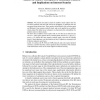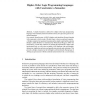177 search results - page 12 / 36 » Linearizing Intuitionistic Implication |
FMCO
2007
Springer
14 years 1 months ago
2007
Springer
This article considers the coordination language Reo, a Petri net variant called zero-safe nets, and intuitionistic temporal linear logic (ITLL). The first part examines the seman...
CVPR
2003
IEEE
14 years 9 months ago
2003
IEEE
The body of work on multi-body factorization separates between objects whose motions are independent. In this work we show that in many cases objects moving with different 3D moti...
SACRYPT
2000
Springer
13 years 11 months ago
2000
Springer
We present and analyze attacks on additive stream ciphers that rely on linear equations that hold with non-trivial probability in plaintexts that are encrypted using distinct keys....
TLCA
2007
Springer
14 years 1 months ago
2007
Springer
A Kripke Semantics is defined for a higher-order logic programming language with constraints, based on Church’s Theory of Types and a generic constraint formalism. Our syntactic...
TABLEAUX
2009
Springer
14 years 3 days ago
2009
Springer
Abstract. Bi-intuitionistic logic is a conservative extension of intuitionistic logic with a connective dual to implication, called exclusion. We present a sound and complete cut-f...



